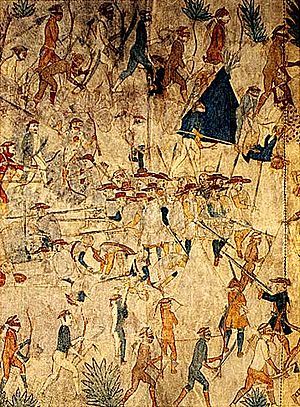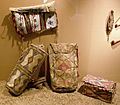Plains hide painting facts for kids
Plains hide painting is a special way of making art by Plains Indians. They painted on animal hides, which are animal skins. These hides could be either soft and tanned or tough and raw.
People painted many things, like their Tipis (cone-shaped homes), tipi liners (inside walls), shields, and special bags called parfleches. They also painted robes, clothes, drums, and even yearly records called winter counts.
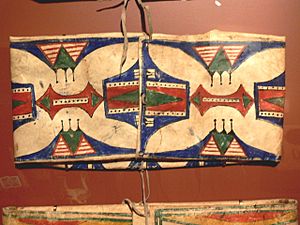
Contents
Different Styles of Hide Painting
Art experts say that Plains artists were very good at making their paintings look balanced and interesting. The designs they used were often similar to older rock art and later art made with porcupine quills or beads.
Geometric Designs
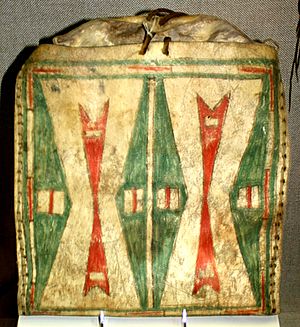
Traditionally, Plains women created abstract designs using shapes and patterns. They loved bright colors and filled areas with solid blocks of color. They only used crisscross lines if they didn't have much paint. Empty spaces in the designs were also very important. Sometimes, they used dots to break up big areas.
Buffalo robes and parfleches often had these geometric patterns. Parfleches were tough rawhide envelopes used to carry and store things, even food. The designs on them might have been like maps, showing abstract shapes of rivers or mountains.
One common design was the "Feathered Sun." This pattern showed stylized feathers in circles. It connected the idea of a feather warbonnet (a special headdress) with the sun.
Paintings of People and Animals
Traditionally, men painted pictures of living things. Plains Indian male artists used a system of simple pictures. These pictures were easy for other people in their tribe to understand. This "picture writing" could be used for many things, like giving directions, drawing maps, or even writing love letters. The images were kept simple, and backgrounds were minimal so everything was clear.
Paintings of people and animals usually fell into two main types: stories of brave deeds or calendars.
Stories of Brave Deeds
Men often painted their battle and hunting adventures on tipi liners, robes, and even shirts. The figures were spread out on the hide, and sometimes images overlapped. These story hides were often "read" from right to left, with the main character appearing from the right side. Friends were usually on the right, and enemies on the left.
Men and horses were often painted. Other common pictures included footprints, hoofprints, symbols for names, bullets, and arrows. One buffalo hide from 1868 shows the main character eight different times!
Painted hides also helped remember important events, like when treaties were signed.
After 1850, hide painting became more detailed. New tools and ideas influenced the art. For example, a 19th-century Omaha tipi even featured steamboats!
Yearly Records (Winter Counts)
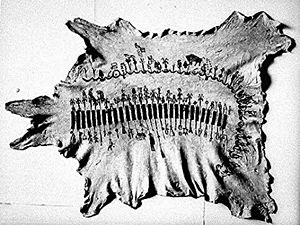
Traditional Plains calendars are called winter counts. This is because most Plains tribes used one simple picture to represent an entire year. Before using the Gregorian calendar, Lakota people counted years from the first snow to the next first snow. The Kiowas were unique because they chose two images per year: one for winter and one for the summer Sun Dance.
Before the late 1800s, when buffalo became scarce, winter counts were painted on buffalo hides. The yearly pictures could be arranged in a straight line, a spiral, or a wavy pattern.
Art from Dreams and Visions
Sometimes, visions and dreams inspired the designs. For example, buckskin covers for round rawhide shields were often inspired by men's visions. These shields could show paintings of humans, animals, or spirit beings. They reflected the owner's personal powers and were believed to offer protection. Warriors who had visions, or medicine men, could share these designs. Cheyenne men who had visions were allowed to make four shields with their special design. Among the Kiowa and Kiowa-Apache tribes, there were about 50 possible shield designs.
Tipis could also be painted with designs from visions. The design and its power belonged to the tipi-owner. This power could be passed down through family, marriage, or even sold among some tribes like the Blackfeet.
Followers of the Ghost dance religion painted visionary designs on their clothing. Arapaho and Lakota Ghost Dance shirts were painted with images of crows, magpies, turtles, and cedar trees.
How They Painted and What They Used
Artists painted on buffalo hides, as well as deer, elk, and other animal skins. Clothes and robes were often "brain-tanned" to make them very soft. Parfleches, shields, and moccasin soles were made from tough rawhide.
In the past, Plains artists used a bone or wood tool called a stylus to paint. They used natural colors made from minerals and plants. Parts of a buffalo rib could be ground down to expose the marrow, which soaked up paint like a modern marker. Swelling cottonwood buds gave a brown color. Lakota artists used to burn yellow clay to make a special red paint for ceremonies. Lakotas also connected blue colors with women.
In earlier times, everyone in a tribe might paint. However, very skilled artists might be asked by others to create artwork for them. Before the 1900s, if a Kiowa man needed to repaint his lodge, he would invite 20-30 friends. They would paint the entire tipi in just one day! Afterward, he would treat them all to a big feast.
Other Art Like This
Many tribes across North America, not just on the Plains, also painted hides. They had their own unique art styles. Tribes in the Subarctic region are known for their painted caribou hides.
On the Plains, when buffalo herds became scarce in the late 1800s, artists started painting on new surfaces. They used muslin cloth, paper, and canvas. This led to a new art form called Ledger art. Today, modern Plains beadwork and jewelry still use designs inspired by old hide paintings.
Images for kids
-
Knife River Villages buffalo robe with the "Feathered Sun" design.
-
Modern painted rawhide hand drums at the National Museum of the American Indian.
Notable Plains Hide Painters
- Kicking Bear, an Oglala Lakota artist.
- Naiche, a Chiricahua Plains Apache artist.
- Silver Horn, a Kiowa artist.
- Tohausen, a Kiowa artist.


